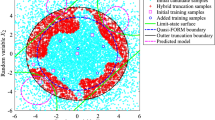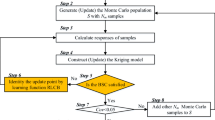Abstract
The prevalence of highly nonlinear and implicit performance functions in structural reliability analysis has increased the computational effort significantly. To solve this problem, an efficiently active learning function, named parameter adaptive expected feasibility function (PAEFF) is proposed using the prediction variance and joint probability density. The PAEFF function first uses the harmonic mean of prediction variances of Kriging model to judge the iteration degree of the current surrogate model, to realize the scaling of the variance in the expected feasibility function. Second, to improve the prediction accuracy of the Kriging model, the joint probability densities are applied to ensure that the sample points to be updated have a higher probability of occurrence. Finally, a new failure probability-based stopping criterion with wider applicability is proposed. Theoretically, the stopping criterion proposed is applicable to all active learning functions. The effectiveness and accuracy of the proposed PAEFF are verified by two mathematical calculations and three engineering examples.









Similar content being viewed by others
References
Metropolis N, Ulam S (1949) The Monte Carlo method [J]. J Am Stat Assoc 44(247):335–341
Hasofer AM, Lind NC (1974) Exact and invariant second-moment code format [J]. J Eng Mech Div 100(1):111–121
Tvedt L (1990) Distribution of quadratic forms in normal space—application to structural reliability [J]. J Eng Mech 116(6):1183–1197
Gaspar B, Teixeira AP, Soares CG (2017) Adaptive surrogate model with active refinement combining Kriging and a trust region method [J]. Reliab Eng Syst Saf 165:277–291
Marelli S, Sudret B (2018) An active-learning algorithm that combines sparse polynomial chaos expansions and bootstrap for structural reliability analysis [J]. Struct Saf 75:67–74
Hariri-Ardebili MA, Pourkamali-Anaraki F (2018) Support vector machine based reliability analysis of concrete dams [J]. Soil Dyn Earthq Eng 104:276–295
Cardoso JB, de Almeida JR, Dias JM et al (2008) Structural reliability analysis using Monte Carlo simulation and neural networks [J]. Adv Eng Softw 39(6):505–513
Zhang X, Lu Z, Cheng K (2021) AK-DS: an adaptive Kriging-based directional sampling method for reliability analysis [J]. Mech Syst Signal Process 156:107610
Jones DR, Schonlau M, Welch WJ (1998) Efficient global optimization of expensive black-box functions [J]. J Glob Optim 13(4):455–492
Bichon BJ, Eldred MS, Swiler LP et al (2008) Efficient global reliability analysis for nonlinear implicit performance functions [J]. AIAA J 46(10):2459–2468
Echard B, Gayton N, Lemaire M (2011) AK-MCS: an active learning reliability method combining Kriging and Monte Carlo simulation [J]. Struct Saf 33(2):145–154
Meng Z, Zhang Z, Li G et al (2020) An active weight learning method for efficient reliability assessment with small failure probability [J]. Struct Multidiscip Optim 61(3):1157–1170
Zheng PJ, Wang CM, Zong ZH et al (2017) A new active learning method based on the learning function U of the AK-MCS reliability analysis method [J]. Eng Struct 148:185–194
Zhang X, Wang L, Sørensen JD (2019) REIF: a novel active-learning function toward adaptive Kriging surrogate models for structural reliability analysis [J]. Reliab Eng Syst Saf 185:440–454
Sun Z, Wang J, Li R et al (2017) LIF: a new Kriging based learning function and its application to structural reliability analysis [J]. Reliab Eng Syst Saf 157:152–165
Hong L, Li H, Peng K (2021) A combined radial basis function and adaptive sequential sampling method for structural reliability analysis [J]. Appl Math Model 90:375–393
Xiao NC, Zuo MJ, Zhou C (2018) A new adaptive sequential sampling method to construct surrogate models for efficient reliability analysis [J]. Reliab Eng Syst Saf 169:330–338
Zhou C, Xiao NC, Zuo MJ et al (2020) AK-PDF: An active learning method combining Kriging and probability density function for efficient reliability analysis [J]. Proceedings of the Institution of Mechanical Engineers, Part O: Journal of Risk and Reliability 234(3):536–549
Wen Z, Pei H, Liu H et al (2016) A sequential Kriging reliability analysis method with characteristics of adaptive sampling regions and parallelizability [J]. Reliab Eng Syst Saf 153:170–179
Lv Z, Lu Z, Wang P (2015) A new learning function for Kriging and its applications to solve reliability problems in engineering [J]. Comput Math Appl 70(5):1182–1197
Shi Y, Lu Z, He R et al (2020) A novel learning function based on Kriging for reliability analysis [J]. Reliab Eng Syst Saf 198:106857
Wang Z, Shafieezadeh A (2019) REAK: reliability analysis through error rate-based adaptive Kriging [J]. Reliab Eng Syst Saf 182:33–45
Echard B, Gayton N, Lemaire M et al (2013) A combined importance sampling and Kriging reliability method for small failure probabilities with time-demanding numerical models [J]. Reliab Eng Syst Saf 111:232–240
Huang X, Chen J, Zhu H (2016) Assessing small failure probabilities by AK–SS: an active learning method combining Kriging and subset simulation [J]. Struct Saf 59:86–95
Fauriat W, Gayton N (2014) AK-SYS: an adaptation of the AK-MCS method for system reliability [J]. Reliab Eng Syst Saf 123:137–144
Bichon BJ, McFarland JM, Mahadevan S (2011) Efficient surrogate models for reliability analysis of systems with multiple failure modes [J]. Reliab Eng Syst Saf 96(10):1386–1395
Yun W, Lu Z, Zhou Y et al (2019) AK-SYSi: an improved adaptive Kriging model for system reliability analysis with multiple failure modes by a refined U learning function [J]. Struct Multidiscip Optim 59(1):263–278
Xing J, Luo Y, Gao Z (2020) A global optimization strategy based on the Kriging surrogate model and parallel computing [J]. Struct Multidiscip Optim 62:405-417
Krige DG (1951) A statistical approach to some basic mine valuation problems on the Witwatersrand [J]. J South Afr Inst Min Metall 52(6):119–139
Sacks J, Schiller SB, Welch WJ (1989) Design for computer experiment [J]. Technometrics 31(1):41–47
Koetler JR, Owen AB (1996) Computer experiments [J]. Handb Stat 13(13):261–308
Lophaven SN, Nielsen HB, Søndergaard J (2002) DACE, A Matlab Kriging toolbox, version 2.0 [J]. Tech. rep
Zhang X, Pandey M D, Yu R, et al. HALK: A hybrid active-learning Kriging approach and its applications for structural reliability analysis [J]. Engineering with Computers, 2021: 1–17.
Guo J, Du X (2009) Reliability sensitivity analysis with random and interval variables [J]. Int J Numer Meth Eng 78(13):1585–1617
Roussouly N, Petitjean F, Salaun M (2013) A new adaptive response surface method for reliability analysis [J]. Probab Eng Mech 32:103–115
Acknowledgements
This research is supported by the National Natural Science Foundation of China under the Contract no. 51975106.
Author information
Authors and Affiliations
Corresponding author
Ethics declarations
Conflict of interest
The authors declare that they have no conflict of interest.
Ethical approval
This article does not contain any studies with human participants or animals performed by any of the authors.
Informed consent
Informed consent was obtained from all individual participants included in the study.
Additional information
Publisher's Note
Springer Nature remains neutral with regard to jurisdictional claims in published maps and institutional affiliations.
Appendix 1: The monotonicity proof of EFF function
Appendix 1: The monotonicity proof of EFF function
The derivative of EFF with respect to prediction variance \(\sigma_{{\overset{\lower0.5em\hbox{$\smash{\scriptscriptstyle\frown}$}}{G} }} ({\varvec{x}})\) can be given as:
Now prove that the partial derivative of the EFF function for the prediction variance is greater than zero. The last three items of Eq. (41), when the \(\frac{{2\sigma_{{\hat{G}}} ({\varvec{x}}) - \overset{\lower0.5em\hbox{$\smash{\scriptscriptstyle\frown}$}}{G} ({\varvec{x}})}}{{\sigma_{{\hat{G}}} ({\varvec{x}})}} \le - 1\), that is less than the abscissa of the inflection point of the standard normal distribution − 1. At this time, the probability density function of the standard normal is an up concave function, therefore:
When \(- 1 < \frac{{2\sigma_{{\hat{G}}} ({\varvec{x}}) - \overset{\lower0.5em\hbox{$\smash{\scriptscriptstyle\frown}$}}{G} ({\varvec{x}})}}{{\sigma_{{\hat{G}}} ({\varvec{x}})}} \le 1\), ignore the \(\phi \left( {\frac{{ - 2\sigma_{{\hat{G}}} ({\varvec{x}}) - \overset{\lower0.5em\hbox{$\smash{\scriptscriptstyle\frown}$}}{G} ({\varvec{x}})}}{{\sigma_{{\hat{G}}} ({\varvec{x}})}}} \right)\), \(\phi \left( {\frac{{2\sigma_{{\hat{G}}} ({\varvec{x}}) - \overset{\lower0.5em\hbox{$\smash{\scriptscriptstyle\frown}$}}{G} ({\varvec{x}})}}{{\sigma_{{\hat{G}}} ({\varvec{x}})}}} \right)\) shows a trend of increasing first and then decreasing, \(2\phi \left( {\frac{{ - \overset{\lower0.5em\hbox{$\smash{\scriptscriptstyle\frown}$}}{G} ({\varvec{x}})}}{{\sigma_{{\hat{G}}} ({\varvec{x}})}}} \right)\) shows a monotonous increasing trend. Because of the nature of concave convex function, the growth rate of \(2\phi \left( {\frac{{ - \overset{\lower0.5em\hbox{$\smash{\scriptscriptstyle\frown}$}}{G} ({\varvec{x}})}}{{\sigma_{{\hat{G}}} ({\varvec{x}})}}} \right)\) is greater than that of \(\phi \left( {\frac{{2\sigma_{{\hat{G}}} ({\varvec{x}}) - \overset{\lower0.5em\hbox{$\smash{\scriptscriptstyle\frown}$}}{G} ({\varvec{x}})}}{{\sigma_{{\hat{G}}} ({\varvec{x}})}}} \right)\). Calculate the value of \(\frac{{ - \overset{\lower0.5em\hbox{$\smash{\scriptscriptstyle\frown}$}}{G} ({\varvec{x}})}}{{\sigma_{{\hat{G}}} ({\varvec{x}})}}\) that satisfies the following formula:
The calculation result of the above formula is \(\frac{{ - \overset{\lower0.5em\hbox{$\smash{\scriptscriptstyle\frown}$}}{G} ({\varvec{x}})}}{{\sigma_{{\hat{G}}} ({\varvec{x}})}} = - \frac{\ln (2)}{2} - 1\), the \(\phi \left( {\frac{{2\sigma_{{\hat{G}}} ({\varvec{x}}) - \overset{\lower0.5em\hbox{$\smash{\scriptscriptstyle\frown}$}}{G} ({\varvec{x}})}}{{\sigma_{{\hat{G}}} ({\varvec{x}})}}} \right) = 2\phi \left( {\frac{{ - \overset{\lower0.5em\hbox{$\smash{\scriptscriptstyle\frown}$}}{G} ({\varvec{x}})}}{{\sigma_{{\hat{G}}} ({\varvec{x}})}}} \right) = 0.322\). For the former term of Eq. (41):
The value of Z(x) is much greater than 0.322, therefore, the value of \(\frac{{\partial E[\overset{\lower0.5em\hbox{$\smash{\scriptscriptstyle\frown}$}}{G} ({\varvec{x}})]}}{{\partial \sigma_{{\overset{\lower0.5em\hbox{$\smash{\scriptscriptstyle\frown}$}}{G} }} ({\varvec{x}})}}\) in interval \(- 1 < \frac{{2\sigma_{{\hat{G}}} ({\varvec{x}}) - \overset{\lower0.5em\hbox{$\smash{\scriptscriptstyle\frown}$}}{G} ({\varvec{x}})}}{{\sigma_{{\hat{G}}} ({\varvec{x}})}} \le 1 - \frac{\ln (2)}{2}\) is still positive. In the interval of \(1 - \frac{\ln (2)}{2} < \frac{{2\sigma_{{\hat{G}}} ({\varvec{x}}) - \overset{\lower0.5em\hbox{$\smash{\scriptscriptstyle\frown}$}}{G} ({\varvec{x}})}}{{\sigma_{{\hat{G}}} ({\varvec{x}})}} \le 2\), the value of Z(x) and \(2\phi \left( {\frac{{ - \overset{\lower0.5em\hbox{$\smash{\scriptscriptstyle\frown}$}}{G} ({\varvec{x}})}}{{\sigma_{{\hat{G}}} ({\varvec{x}})}}} \right)\) show a single increasing trend. But the maximum function value of \(2\phi \left( {\frac{{ - \overset{\lower0.5em\hbox{$\smash{\scriptscriptstyle\frown}$}}{G} ({\varvec{x}})}}{{\sigma_{{\hat{G}}} ({\varvec{x}})}}} \right)\) is obtained at \(\frac{{ - \overset{\lower0.5em\hbox{$\smash{\scriptscriptstyle\frown}$}}{G} ({\varvec{x}})}}{{\sigma_{{\hat{G}}} ({\varvec{x}})}} = {0}\). The maximum value is \(2\phi \left( {\frac{{ - \overset{\lower0.5em\hbox{$\smash{\scriptscriptstyle\frown}$}}{G} ({\varvec{x}})}}{{\sigma_{{\hat{G}}} ({\varvec{x}})}}} \right)_{\max } { = 0}{\text{.80 < 1}}{.49}\). Therefore, it is always true that \(\frac{{\partial E[\overset{\lower0.5em\hbox{$\smash{\scriptscriptstyle\frown}$}}{G} (x)]}}{{\partial \sigma_{{\overset{\lower0.5em\hbox{$\smash{\scriptscriptstyle\frown}$}}{G} }} (x)}}\) is greater than zero in the interval of \(- 1 < \frac{{2\sigma_{{\hat{G}}} ({\varvec{x}}) - \overset{\lower0.5em\hbox{$\smash{\scriptscriptstyle\frown}$}}{G} ({\varvec{x}})}}{{\sigma_{{\hat{G}}} ({\varvec{x}})}} \le 2\). To sum up, it is known from the symmetry of the standard normal function that \(\frac{{\partial E[\overset{\lower0.5em\hbox{$\smash{\scriptscriptstyle\frown}$}}{G} ({\varvec{x}})]}}{{\partial \sigma_{{\overset{\lower0.5em\hbox{$\smash{\scriptscriptstyle\frown}$}}{G} }} ({\varvec{x}})}}\) is greater than zero in the whole interval. To sum up, it is known from the symmetry of the standard normal function that \(\frac{{\partial E[\overset{\lower0.5em\hbox{$\smash{\scriptscriptstyle\frown}$}}{G} ({\varvec{x}})]}}{{\partial \sigma_{{\overset{\lower0.5em\hbox{$\smash{\scriptscriptstyle\frown}$}}{G} }} ({\varvec{x}})}}\) is greater than zero in the whole interval. Therefore, it can be seen that the EFF function is a monotonic function about the prediction variance.
Rights and permissions
Springer Nature or its licensor (e.g. a society or other partner) holds exclusive rights to this article under a publishing agreement with the author(s) or other rightsholder(s); author self-archiving of the accepted manuscript version of this article is solely governed by the terms of such publishing agreement and applicable law.
About this article
Cite this article
Xu, H., Zhang, W., Zhou, N. et al. An active learning Kriging model with adaptive parameters for reliability analysis. Engineering with Computers 39, 3251–3268 (2023). https://doi.org/10.1007/s00366-022-01747-x
Received:
Accepted:
Published:
Issue Date:
DOI: https://doi.org/10.1007/s00366-022-01747-x




